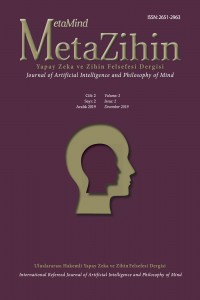Artificial Intelligence and Singularity: How Close Are We to Technological Singularity and Why Is It Important?
Öz
The growth rate of information technologies, which are closely related to artificial intelligence, is increasing by time, as growth rate of many technological and scientific fields do. This fact paves the way for the growth rate of technological and scientific development to reach a point that cannot be traced by today's institutions, methods, tools and mental capacity of today’s human beings. This hypothetical state is called “technological singularity” and one of the most critical steps to achieve singularity is achievement of artificial general intelligence. As Ray Kurzweil (2005) states, when people try to predict the future of technological developments, they tend to assume that the current growth rate will remain constant throughout the progress. Therefore, intuitively, they tend to think that the artificial general intelligence and the technological singularity will be realized in a distant future. In this paper, I will discuss the validity of this idea and argue that singularity is much closer than we intuitively expect. Moore's law and information processing capacity necessary to simulate human brain show that it is a realistic expectation to achieve singularity in the next two or three decades. Indeed, with social, legal and economic regulations, we can enter this era earlier, later or in a more controlled way. This paper underlines the importance of singularity for the humanity and emphasizes the urgency of decisions about singularity and artificial intelligence.
Anahtar Kelimeler
technological singularity artificial intelligence artificial general intelligence technological progress Moore's law
Kaynakça
- Chalmers, D. J. (2010). “The Singularity: A Philosophical Analysis.” Journal of Consciousness Studies, 17: 7-65.
- Good, I. J. (1966). “Speculations Concerning the First Ultraintelligent Machine.” F. L. Alt ve M. Rubinoff (Der.), Advances in Computers içinde (Vol. 6) (s. 31-88). New York: Academic Press Inc.
- Kaku, M. (1999). Visions: How Science Will Revolutionize the 21st Century. Oxford: Oxford University Press.
- Kurzweil, R. (2005). The Singularity is Near: When Humans Transcend Biology. New York: The Viking Press.
- “Life Expectancy at Birth.” (2019, 2 Aralık). Alındığı URL: https://data.worldbank.org/indicator/SP.DYN.LE00.IN
- Markram, H. J. (2006). “The Blue Brain Project.” Nature Rewievs Neuroscience, 7(2): 153-160.
- Moore, G. E. (1965). “Cramming More Components onto Integrated Circuits.” Proceedings of the IEEE, 86(1): 82-85.
- Moore, G. E. (1975). “Progress in Digital Integrated Electronics.” Electron Devices Meeting, 21: 11-13.
- Moore, G. E. (2006). “Moore's Law at Forty.” D. Brock (Der.), Understanding Moore's Law: Four Decades of Innovation içinde (s. 67-84). Philadelphia: Chemical Heritage Press.
- “Poverty.” (2019, 3 Aralık). Alındığı URL: https://data.worldbank.org/topic/poverty
- Roser, M. (2019, 3 Aralık). “Working Hours.” Alındığı URL: https://ourworldindata.org/working-hours
- Roser, M. ve Ritchie, H. (2019, 9 Aralık). “Technological Progress.” Alındığı URL: https://ourworldindata.org/technological-progress
- Searle, J. R. (1980). “Minds, Brains, and Programs.” The Behavioral and Brain Sciences, 3(3): 417-457.
- Vinge, V. (2017). “The Coming Technological Singularity: How to Survive in a Post-Human Era.” R. Latham (Der.), Science Fiction Criticism: An Anthology of Essential Writings içinde (s. 352-365). London: Bloomsbury Academic.
Öz
Başta yapay zekâ ile yakından ilişkili olan bilişim teknolojileri olmak üzere, teknolojinin ve bilimin birçok alanı hızını arttırarak gelişmektedir. Bu gerçek, teknolojik ve bilimsel gelişme hızının bugünün kurum, yöntem, araç ve insanının zihinsel kapasitesiyle takip edilemeyecek bir noktaya ulaşma ihtimalinin önünü açmaktadır. Bu hipotetik durum “teknolojik tekillik” olarak adlandırılmaktadır ve tekilliğe ulaşmamız için atılabilecek en kritik adımlardan birisi yapay genel zekâ araştırmalarının başarıya ulaşmasıdır. Ray Kurzweil’in (2005) ifade ettiği gibi, insanlar teknolojik gelişmelerin geleceğini tahmin etmeye çalışırken, mevcut gelişme hızının devam edeceği varsayımını yapmak eğilimindedirler. Bu nedenle de, sezgisel olarak, yapay genel zekânın oluşturulması ve teknolojik tekilliğin gerçekleşmesinin daha uzak bir gelecekte gerçekleşeceğini düşünmek eğilimdedirler. Bu düşüncenin ne ölçüde geçerli olduğunu tartışmaya açacağım yazıda, tekilliğin sezgilerimizi büyük bir hata payıyla yanıltacak kadar yakın olduğunu savunacağım. Moore yasası ve insan beynini simüle etmek için gerekli bilgi işleme kapasitesini, önümüzdeki yirmi ile otuz yıl arasında tekilliğe ulaşmamızın gerçekçi olabileceğini göstermektedir. Şüphesiz, sosyal, hukuki ve ekonomik düzenlemelerle, bu sürece daha hızlı, daha yavaş ya da daha kontrollü biçimde girmemiz mümkündür. Tekilliğin insanlık tarihi açsından öneminin altının çizileceği yazıda, tekillik ve yapay zekâ ile ilgili alınacak kararların aciliyetine vurgu yapılacaktır.
Anahtar Kelimeler
teknolojik tekillik yapay zekâ yapay genel zekâ teknolojik ilerleme Moore yasası
Kaynakça
- Chalmers, D. J. (2010). “The Singularity: A Philosophical Analysis.” Journal of Consciousness Studies, 17: 7-65.
- Good, I. J. (1966). “Speculations Concerning the First Ultraintelligent Machine.” F. L. Alt ve M. Rubinoff (Der.), Advances in Computers içinde (Vol. 6) (s. 31-88). New York: Academic Press Inc.
- Kaku, M. (1999). Visions: How Science Will Revolutionize the 21st Century. Oxford: Oxford University Press.
- Kurzweil, R. (2005). The Singularity is Near: When Humans Transcend Biology. New York: The Viking Press.
- “Life Expectancy at Birth.” (2019, 2 Aralık). Alındığı URL: https://data.worldbank.org/indicator/SP.DYN.LE00.IN
- Markram, H. J. (2006). “The Blue Brain Project.” Nature Rewievs Neuroscience, 7(2): 153-160.
- Moore, G. E. (1965). “Cramming More Components onto Integrated Circuits.” Proceedings of the IEEE, 86(1): 82-85.
- Moore, G. E. (1975). “Progress in Digital Integrated Electronics.” Electron Devices Meeting, 21: 11-13.
- Moore, G. E. (2006). “Moore's Law at Forty.” D. Brock (Der.), Understanding Moore's Law: Four Decades of Innovation içinde (s. 67-84). Philadelphia: Chemical Heritage Press.
- “Poverty.” (2019, 3 Aralık). Alındığı URL: https://data.worldbank.org/topic/poverty
- Roser, M. (2019, 3 Aralık). “Working Hours.” Alındığı URL: https://ourworldindata.org/working-hours
- Roser, M. ve Ritchie, H. (2019, 9 Aralık). “Technological Progress.” Alındığı URL: https://ourworldindata.org/technological-progress
- Searle, J. R. (1980). “Minds, Brains, and Programs.” The Behavioral and Brain Sciences, 3(3): 417-457.
- Vinge, V. (2017). “The Coming Technological Singularity: How to Survive in a Post-Human Era.” R. Latham (Der.), Science Fiction Criticism: An Anthology of Essential Writings içinde (s. 352-365). London: Bloomsbury Academic.
Ayrıntılar
| Birincil Dil | Türkçe |
|---|---|
| Konular | Felsefe |
| Bölüm | Araştırma/İnceleme Makaleleri |
| Yazarlar | |
| Yayımlanma Tarihi | 30 Aralık 2019 |
| Kabul Tarihi | 29 Aralık 2019 |
| Yayımlandığı Sayı | Yıl 2019 Cilt: 2 Sayı: 2 |


